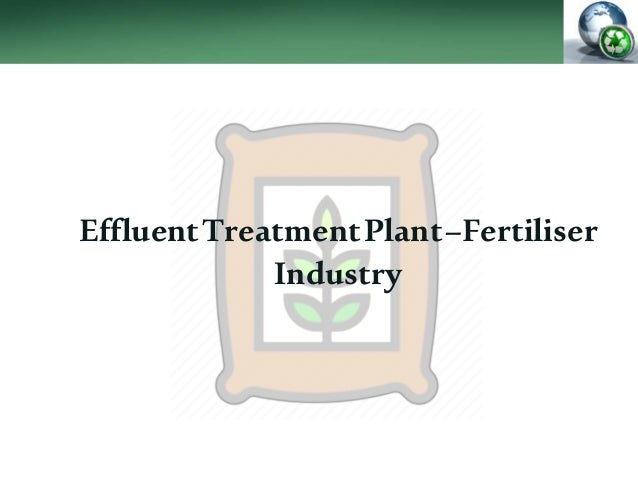
Effluent Treatment Plant - AICHE 09.04.2022.pptx
- 2. About Fertilizer Industry Chemical Fertilizer Industry Phosphatic Fertilizer (DAP, NPK grades , Single superphosphate Nitrogenous Fertilizer ( Urea) , calcium ammonium nitrate, ammonium sulphate etc Sulphuric Acid SSP DAP / NPK Sulphuric Acid SSP DAP / NPK Phosphoric acid Sulphur Rock Phosphate Phosphoric acid Ammonia MOP RAW MATERIALS MFG PLANTS PRODUCTS Phosphatic Fertilizer Complex Products and Raw materials :
- 4. Why ETP plant is required ? ETP (Effluent Treatment Plant) is a process design for treating the industrial waste water for its reuse or safe disposal to the environment. Removal of high amounts of organic compounds debris, dirt, grit, pollution, toxic, non-toxic materials and polymers etc. from industrial effluent How may ETP plants are there ? 1. Effluent Treatment Plants (ETP) 2. Sewage Treatment Plants (STP) 3. Common and Combined Effluent Treatment Plants (CETP). Benefits : Provides clean, safe water processed..... Reuse of water. Saving you money. ... Beneficial to the environment. ... Saving water. ... A way to minimise waste Objective of Effluent Treatment
- 5. Treatment Levels : Primary o Example: pH control, coagulation, chemical precipitation and oxidation. Secondary o Biological process ( Activation sludge process/ Membrane bioreactor /Moving Bed biofilm reactor) Tertiary o Disinfection using Sodium hypochlorite Treatment Mechanisms : Physical Chemical Biological Treatment Level & Mechanism of ETP
- 6. Characteristics of Influent Fertiliser Industry Waste water Generated from Sulphuric acid plant : Waste heat boiler blowdown , acidic waste water from spillage , leakage of plant and equipment. Waste water generated from Single Superphosphate plant : Effluent bearing phosphate , fluoride , suspended soild, Low PH from scrubber and nearby surface drains. Waste water generated from DAP/NPK plant: Waste water from draining and washing of equipment containing phosphate , fluoride and low PH Others cooling tower , boiler blowdown utility effluent high TDS Waste water generated from phosphoric acid plant: Gypsum pond water containing high phosphate and fluoride Waste water generated from ammonia , urea plant: Ammoniacal Nirogen , Total Nitrogen , kjeldahl Nirogen , Nitrate Nirogen etc process condensate .
- 7. ETP Process & Block diagram –Phosphate & Fluoride removal Equalisation Tank FM-1 FM-2 FM-3 Clarifier Sludge Drying Bed DM plant regeneration & RO reject Cooling tower & boiler blowdown &Sulphuric acid plant floor wash , DAP/ SSP Plant wash water Sludge Thickener Semi Solid Sludge disposed to WBWML, TSDF facility Overflow PSF Treated effluent discharge to drain Underflow Polyelectrolyte ETP sludge Flter liquor of ETP Sludge ETP operation is physicochemical process to remove phosphate and fluoride In FM 1, dry lime is added to maintain pH of the solution (12 -12.5) .Phosphate and fluoride is removed as precipitate of calcium phosphate and calcium fluoride in FM 2 alum solution is added to maintain pH 10-10.5 . At pH 10.5, rate of reverse reaction Ca+F2 CaF2 decreases. Hydrochloric acid is added in FM3 to maintain pH discharge limit ( 6.5-8.5) Polyelectrolyte is added in FM3 overflow to Clarifier for settling of sludge. The wet solid sludge collected is sent to WBWML, a TSDF Facility. Polyelectrolyte Polyelectrolyte HCL Alum Solution FM – Flash Mixture PSF-Pressure Sand Filter STP- Sewage treatment plant Dry lime /lime Soln Partially use in DAP& SSP plant
- 8. PFD of ETP
- 9. Improvement based on treatability study Sl No Area of Improvement As Design Improvement over design 1 FM#1 (Flash Mixer) Lime solution addition system & maintain pH 12.0 – 12.5 manually. Dry lime addition system with screw conveyor fitted with VVF drive & on-line pH measuring device to control process. 2 FM#2 (Flash Mixer) Alum solution addition to maintain pH 7.5 – 8.5 manually. Control valve along with flow meter provided at feed line to auto control pH and range changes to 10.0 – 10.5. 3 FM#3 (Flash Mixer) Poly electrolyte addition by metering pump inside clarifier. HCl dosing to control pH at 6.5 – 8.5 with auto dosing facilities. Poly electrolyte added to O’flow of FM3 4 Online analyser Installation PH, fluoride, BOD, COD, TSS parameter measuring analyser 5 Pump tripping with high discharge value - Final dischrage pump tripping logic with high value than permissible limit 6 Display of all parameters of discharge in ETP Plant & Alarm/Hooter system - Final discharge all parameters are displayed in plant for better monitoring. Alarm /hooter system installed in case of any sudden rise of any parameter in final discharge 7 ETP Sludge handling Mix with Gypsum Construction of sludge drying bed
- 10. ETP Discharge Norms Sl No Pollutants Prescribed Standards (Consent Limits) 1 pH Between 6.5 - 8.5 2 TSS Not exceed 100 mg/L 3 BOD Not exceed 30 mg/L 4 COD Not exceed 250 mg/L 5 Oil & Grease Not exceed 10 mg/L 6 Phosphate Not exceed 5 mg/L 7 Fluorides Not exceed 10 mg/L 8 Ammonical Nitrogen as N Not exceed 50 mg/L 9 Kjeldhal Nitrogen as N Not to exceed 75 mg/L 10 Free Ammonical Nitrogen as N Not to exceed 4 mg/L
- 11. Domestic Process Flow Diagram Domestic Receiving Tank Aeration Tank Domestic Clarifier Up-flow Filter Sludge drying bed Dom. Treated water sump Dom. PSF Dom. Treated water dis. sump Domestic sludge tr. pump NaOCl Urea + DAP To final discharge Sewage input from toilet , canteen waste water
